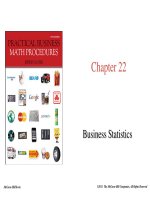Lecture Practical business math procedures (11/e) - Chapter 7: Discounts: trade and cash
Bạn đang xem bản rút gọn của tài liệu. Xem và tải ngay bản đầy đủ của tài liệu tại đây (388.73 KB, 19 trang )
Discounts: Trade
and Cash
McGrawHill/Irwin
Chapter Seven
Copyright © 2014 by The McGrawHill Companies, Inc. All rights reserved.
Learning unit objectives
LU 7-1: Trade Discounts—Single and Chain
(Includes Discussion of Freight)
1.
Calculate single trade discounts with formulas
and complements.
2.
Explain the freight terms FOB shipping point
and FOB destination.
3.
Find list price when net price and trade discount rate are known.
4.
Calculate chain discounts with the net price equivalent rate and
single equivalent discount rate.
LU 7-2: Cash Discounts, Credit Terms, and Partial Payments
5.
List and explain typical discount periods and credit periods that a
business may offer.
6.
Calculate outstanding balance for partial payments.
72
Invoice
73
Trade Discount Amount &
Net Price Formulas
List price x Trade discount rate = Trade discount
amount
$5,678 x 25% = $1,419.50
List price -- Trade discount amount = Net
Price
$5,678 -- 1,419.50 = $4,258.50
74
Freight Terms
From Buyer
FOB Shipping Prospective
Point -buyer pays the freight cost
FOB New Jersey -the buyer in San Diego pays the
freight
b
u
y
e
r
s
e
ll
e
r
From Seller
Prospective
FOB Destination -seller pays the freight cost
FOB San Diego the
- seller in New Jersey pays the freight
75
Complement
Complement - The difference between
the single discount rate and 100%.
The complement is what percentage
the buyer will pay.
Complement
75%
25%
For example, if the trade discount is
25%, the complement is 75%
(100% -- 25%).
Trade
Discount
76
Single Trade Discount
The price of a Macintosh computer is $2,700. The manufacturer
offers a 40% trade discount. What are the trade discount amount
(TDA) and the net price?
TDA = $2,700 x .40 = $1,080
Net price = $2,700 -- $1,080 = $1,620
Using Complement:
$2,700 x .60 = $1,620
77
Calculating List Price When Net Price & Trade
Discount Rate Are Known
List Price =
Net Price
Complement of trade discount rate
.
Example:
A Macintosh computer has a $1,620 net price and a 40%
trade discount. What is the list price?
100% -- 40% = 60%
$1,620
.60 = $2,700 list price
78
Chain Discounts
Chain discounts are trade discounts in a series of two or
more successive discounts. For example: 20/15/10.
To find the net price equivalent rate,
multiply the complements:
100% 100%
- 20
- 15
100%
- 10
.80 x .85 x .90 = .612 net price
%
Warning: Do not just add up the discounts to
calculate the discount!
20 + 15 + 10 =
45%
.20 x .15 x .10 = .388 net trade discount
79
Calculating Net Price with a
Chain Discount
The price of office equipment is $15,000. With a chain discount
of 20/15/10, what is the net price?
$15,000 $15,000 $12,000
$10,200
x .20
-- 1,020
-- 3,000 -- 1,800
$3,000 $12,000 $10,200
x
.15 x
$1,800
$9,180
.10
$1,020
710
Calculating Net Price Using Net Price
Equivalent Rate
The price of office equipment is $15,000. With a chain
discount of 20/15/10, what is the net price?
Find the net price equivalent rate by multiplying the complements:
.80 x .85 x .90 = .612
To find the net price, multiply the net price equivalent rate by the list
price:
$15,000 x .612 = $9,180
Trade discount amount:
$15,000 -- $9,180 = $5,820
711
Calculating Trade Discount Amount Using
Single Equivalent Discount Rate
The price of office equipment is $15,000. With a chain
discount of 20/15/10, what is the net price?
Find the net price equivalent rate by multiplying the complements:
.80 x .85 x .90 = .612
To find the single equivalent discount rate, subtract the net price
equivalent rate from 1:
1.00 -- .612 = .388
Trade discount amount:
$15,000 x .388 = $5,820
712
Cash Discounts
A cash discount is for prompt payment. It is not taken on freight,
returned goods, sales tax, or trade discounts.
Credit Period
Mar. 1
Mar. 31
Time period sellers give buyers to pay invoices.
Discount Period
Mar. 1
Mar. 10
Time period buyer has to take advantage of cash discount.
713
Invoice
714
Ordinary Dating Method
2/10, n/30 is read: “two ten, net thirty”
Example: $400 invoice dated July 5; terms 2/10, n/30; paid on July 11.
$400 x.02 = $8 cash discount
$400 -- $8 = $392 paid
or
$400 x .98 = $392
715
Receipt of Goods (ROG)
3/10, n/30 ROG - Cash discount period begins when the buyer receives the
goods.
Example: $900 invoice dated May 9, received goods July 8; terms 3/10, n/30
ROG; paid on July 20.
716
End of Month (EOM)
1/10 EOM -- 1% discount, up until the 10th of the following month.
Example: $600 invoice dated July 6; terms 1/10 EOM; paid on August 10.
$600 x .01 = $6
$600 -- $6 = $594
or
$600 x .99 = $594
717
End of Month (EOM)
2/10 EOM – Considered the “25th rule;” skip a month
Example: $800 invoice dated April 29; terms 2/10 EOM; paid on June 18.
No discount; $800 paid.
718
Partial Payment
Molly McGrady owes $400. Molly’s terms were 2/10, n/30. Within 10 days Molly
sent in a payment of $80. How much is her new balance?
100% -- 2% = .98
$80
.98 = $81.63
(1 -- .02)
Step 1. Find the complement of discount
rate. partial payment by the
Step 2. Divide
complement (amount credited).
Step 3. Subtract Step 2 from the
amount owed (outstanding
balance).
$400 -- $81.63 = $318.37
719









